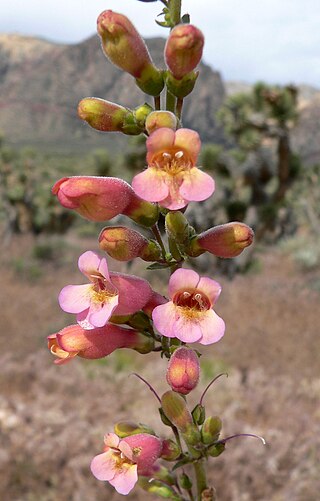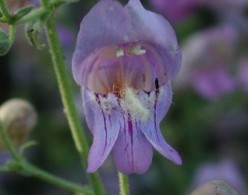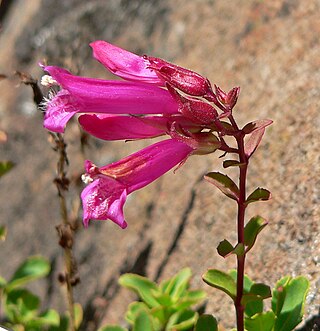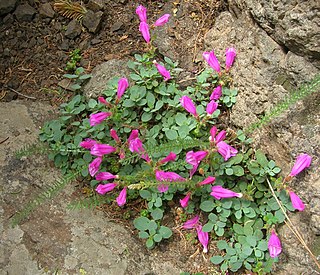
Penstemon anguineus is a species of penstemon known by the common name Siskiyou beardtongue. It is native to the mountains of Oregon and northern California, where it grows in coniferous forests, often in open areas left by logging operations. It is a perennial herb reaching up to about 90 centimeters in maximum height. The oppositely arranged leaves are lance-shaped to oval, the ones higher on the plant clasping the stem. The inflorescence produces several light blue or purple flowers between 1 and 2 centimeters long. The sepals and flowers are coated in glandular hairs. The inside of the flower has many long hairs and the staminode has a sparse hair coating.
Penstemon barnebyi is a species of penstemon known by the common names White River Valley beardtongue and Barneby's beardtongue. It is native to the mountain and basin territory of central western Nevada, where it grows in sagebrush and woodland; there is also one occurrence just over the California border. This is a hairy perennial herb with erect branches reaching 30 centimeters (1 ft) in maximum height. The oppositely arranged leaves are lance-shaped and up to 7.5 centimeters (3 in) long. There are usually several located around the base of the plant. The inflorescence produces tubular flowers just over one-half centimeter long. They are light purple with a purple-striped white throat lined with yellowish hairs. The protruding staminode is covered in bright orange hairs.

Penstemon bicolor is a species of penstemon known by the common name pinto beardtongue. It is native to the desert mountains and valleys of southern Nevada, eastern California, and western Arizona, where it grows in scrub, woodland, and other local habitat. It is a perennial herb which may exceed one meter in maximum height. The thick, serrated leaves are oppositely arranged and some pairs are fused around the stem at the bases. The inflorescence produces tubular flowers around 2 to nearly 3 centimeters long in many shades of yellow and pink, usually with striping in the throats. The flower's throat is hairy and the staminode just inside is coated in long yellowish hairs.
Penstemon caesius is a species of penstemon known by the common name San Bernardino beardtongue. It is endemic to California, where it is known from the San Bernardino and San Gabriel Mountains, as well as the southern mountains of the Sierra Nevada. It is a member of the flora on rocky slopes and in coniferous forests and alpine habitat in the mountains. It is a perennial herb with erect branches up to about 80 centimeters in maximum height. The lower branches may be woody, the upper hairless and waxy, and the inflorescence glandular. Most of the leaves are basal on the plant, rounded or oval, and up to about 4 centimeters long. The inflorescence produces purple-blue tubular flowers roughly 2 centimeters long. The flower has a glandular outer surface, a coat of hairs inside, and a hairless staminode. The flowers of this penstemon are pollinated by bees of genus Osmia, which feed on their nectar.
Penstemon calcareus is a species of penstemon known by the common name limestone beardtongue. It is native to California, where it is known from the deserts of central San Bernardino County, as well as the Death Valley area, where its distribution extends just over the border into Nevada. It grows in scrub and woodland, often on limestone substrates. It is a perennial herb with erect branches up to about 25 centimeters in maximum height, grayish with a coating of fine hairs. The toothed, lance-shaped leaves are up to 6 centimeters long. The inflorescence produces bright pink to purplish tubular or funnel-shaped flowers between 1 and 2 centimeters long. The flower has a glandular outer surface and a staminode coated with yellow hairs.
Penstemon cinicola is a species of penstemon known by the common name ash penstemon. It is native to northeastern California and southern Oregon, where it grows in forests and plateau habitat. It is a perennial herb with upright branches 40 centimeters (16 in) maximum height. The leaves are 3 to 6 centimeters long, linear in shape, folded lengthwise, and curved backwards. The inflorescence produces tubular flowers with wide lipped mouths. The flower is blue-purple in color, just under one centimeter long, and hairless except for hairs on the floor of the mouth and on the staminode.

Penstemon gracilentus is a species of penstemon known by the common names slender beardtongue and slender penstemon. It is native to the mountains and sagebrush plateau of northeastern California, western Nevada, and southern Oregon, where it grows in forest, woodland, and scrub habitat. It is a perennial herb producing upright branches to about 65 centimeters in maximum height, the stems developing woody bases. The leaves are up to 10 centimeters in length and linear or lance-shaped. The glandular inflorescence produces several tubular purple flowers up to 2 centimeters long. The mouth of each flower may be hairless or coated in long hairs, and the staminode usually has a coat of yellow hairs.

Penstemon grinnellii is a species of penstemon known by the common name Grinnell's beardtongue. It is endemic to California, where it can be found in several mountain ranges from those around the San Francisco Bay Area to the Sierra Nevada to the Peninsular Ranges near the Mexican border. It is a perennial herb producing upright stems growing to 85 centimeters in maximum height. The leaves are oblong, up to 9 centimeters in length, folded lengthwise and curved backward. The glandular inflorescence produces several tubular purple-tinged white or violet flowers 1 to 2 centimeters long. The mouth of the flower has three lower lobes streaked with dark lines, a hairy throat and a long-haired, protruding staminode.

Penstemon heterodoxus is a species of penstemon known by the common name Sierra beardtongue. It is native to California and western Nevada where it grows in several of the mountain ranges from the Klamath Mountains to the Sierra Nevada - and the slopes and plateaus to the east. It grows in subalpine and alpine climates in mountain forests, meadows and talus.

Penstemon monoensis is a species of penstemon known by the common name Mono penstemon. It is endemic to the White and Inyo Mountains of eastern California, where it grows in scrub, woodland, and sandy washes. It is a perennial herb growing erect to about 30 centimeters tall, gray-green in color from a dense coating of light hairs. The paired leaves are lance-shaped, sometimes toothed or wavy along the edges and up to 12 centimeters long. The glandular inflorescence bears cylindrical or funnel-shaped flowers in shades of bright to deep pink, measuring around 2 centimeters in length. The mouth of the flower may have a white or pale area on the floor with a patch of hairs, and the staminode is usually hairy.

Penstemon newberryi is a species of penstemon known by the common name mountain pride or Newberry's penstemon. It is native to the mountains of northern California, Oregon, and Nevada, where it grows in rocky habitat, often at high elevation, such as talus. It is a bushy, mat-forming subshrub growing up to 30 centimeters tall. The leaves are mostly basal on the plant, oblong or oval and toothed, measuring 1 to 4 centimeters in length, with a few smaller pairs along the stem. The glandular inflorescence bears showy magenta flowers 2 to over 3 centimeters in length. The flower is generally tubular or funnel-shaped and has a coating of short to long and curly hairs in the mouth and on the staminode.
Penstemon pahutensis is a species of penstemon known by the common name Pahute Mesa beardtongue, or simply Pahute beardtongue. It is native to the desert hills and mountains of southern Nevada, including the Pahute Mesa for which it is named. It can also be found in a few areas over the border in California. It is a perennial herb growing up to 35 centimeters (14 in) tall. The paired, narrow leaves are linear to lance-shaped and up to 10 centimeters (4 in) long. The inflorescence bears blue-purple flowers up to 3 centimeters long. The inside of the wide mouth of the flower is lined with white or yellow hairs, and the staminode is coated in yellow hairs.
Penstemon personatus is an uncommon species of penstemon known by the common name closethroat beardtongue.

Penstemon procerus is a species of penstemon known by the common name littleflower penstemon. It is native to western North America from Alaska to California to Colorado, as far east in Canada as Manitoba, where it grows in mountain habitat such as meadows, often in alpine climates. This herbaceous perennial forms mats of herbage with some erect stems reaching about 40 centimeters in maximum height. There are several varieties which vary in morphology, some more decumbent than others, some of which are known commonly as pincushion penstemons for their matted forms. In general, the leaves are lance-shaped to oval, plentiful around the base of the plant with smaller ones arranged in opposite pairs along the stem. The inflorescence is made up of one or more clusters of tubular flowers with lipped, lobed mouths. Each flower is no more than one centimeter in length and is purple to blue in color, often with a white throat. The outside of the flower is generally hairless, while the inside may be lined with white or yellowish hairs.

Penstemon roezlii is a species of penstemon known by the common name Roezl's penstemon. It is native to Oregon, western Nevada, and adjacent sections of northern California, including the Klamath Mountains and Sierra Nevada, where it grows in sagebrush and forest habitat types. It is a hairy, erect perennial herb growing to a maximum height of 55 centimeters from a woody, branching base. The leaves are up to 7 centimeters long, linear to widely lance-shaped and often folded lengthwise. The glandular inflorescence bears wide-mouthed tubular flowers up to 2.2 centimeters long in shades of blue-purple. The flowers are mostly hairless except for thin glandular hairs on the outer surfaces.

Penstemon rupicola is a species of penstemon known by the common names cliff beardtongue or rock penstemon. It is native to the west coast of the United States from Washington to the Klamath Mountains of far northern California, where it grows in rocky mountainous habitat. It is a clumpy, mat-forming subshrub growing no more than 14 centimeters high. The thick, waxy, oppositely arranged leaves are round or oval and up to 2 centimeters long. The showy wide-mouthed tubular flowers emerging from the mat may be nearly 4 centimeters in length and are shades of light purple to bright pink.

Penstemon spectabilis is a species of penstemon known by the common name showy penstemon or showy beardtongue. It is native to southern California and Baja California, where it grows in the chaparral, scrub, and woodlands of the coastal mountain ranges.

Penstemon venustus is a species of penstemon known by the common names Venus penstemon and alpine penstemon. It is native to the northwestern United States, where it grows in many types of open habitat. It is a spreading shrub growing erect to a maximum height near 80 centimeters. The thick, stiff leaves are lance-shaped, serrated, and up to 12 centimeters in length. The showy inflorescence bears many tubular lavender flowers, the largest nearly 4 centimeters long. The mouth of the flower and the staminode are covered in long, white hairs. This penstemon is cultivated for use in wilderness landscaping in its native habitat.

Penstemon pinorum is a rare species of flowering plant in the plantain family known by the common names Pine Valley penstemon and pinyon penstemon. It is endemic to Utah in the United States, where it is known only from an area along the border between Washington and Iron Counties.

Penstemon degeneri is a species of flowering plant in the plantain family known by the common name Degener's beardtongue. It is endemic to Colorado in the United States, where it occurs in and around the Arkansas River Canyon in Fremont, Custer, and Chaffee Counties.















